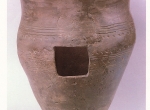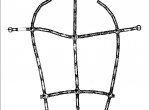Olsztyn Group
Olsztyn Group (in pre-1945 literature masurgermanische Kultur), developed in Mazuria starting from the turn of the early and the late Migration Period (phases D/E) until the 7th century, possibly even the onset of 8th century. Because of the concentration of interregional elements of Germanic culture (bow brooches →Bow brooch in particular, fig. 1.), rarely seen in this part of Europe, the O. g. was thought to have taken form as a result of migration of various →Germanic Tribes to Mazuria, or alternately, of the return to the region of the descendants of the Balt Galindians who had migrated south with the Goths. Recent studies indicate that the participation of the local Balt environment was decisive for the rise and development of the O. g. The burial rite (cremation, urned - fig. 2. or in pits, horse graves - fig. 3) and elements of material culture (brooch forms, belt fittings - fig. 4., pottery) are local in character. The people of the Olsztyn Group continued using many cemeteries of their predecessor Bogaczewo Culture (phases A3/B1–D); they also established new burial grounds, e.g., in the western area of Mazuria left desolate by the departure of the →Wielbark Culture people. Of major significance in the development of the O. g. was long-distance exchange – with the lands on the Danube and the Black Sea, with Scandinavia and western Europe. Next to numerous imports from that area a large group of finds from Mazuria are imitations of non-local designs from the same source areas (especially, bow brooches →Bow brooch and also, belt fittings). Germanic influence is evident also in the sphere of ideology - no weapons deposited in graves (influence of the →Goths ), distinctive urn forms (window urns, influence of the Saxons). The matter of the decline of the O. g. and the rise of the early medieval Prussian culture in Mazuria remains open.
AB-W
Literature: W. Nowakowski, Die Olsztyn-Gruppe (masurgermanische Kultur) in der Völkerwanderungszeit. Das Problem ihrer chronologischen und territorialen Grenzen, [in:] M. Mączyńska, T. Grabarczyk (ed.), Die spätrömische Kaiserzeit und die frühe Völkerwanderungszeit in Mittel- und Osteuropa, Łódź 2000, p. 168-180; J. Kowalski, Chronologia grupy elbląskiej i olsztyńskiej kręgu zachodniobałtyjskiego (V–VII w.). Zarys problematyki, „Barbaricum“ vol. 6, Warszawa 2000, p. 203-266; A. Bitner-Wróblewska, Die Periodisierung der Gräberfelder von Tumiany (Daumen) und Kielary (Kellaren). Ein Beitrag zur Diskussion über den Ursprung der Olsztyn-Gruppe, [in:] A. Bitner-Wróblewska, C. von Carnap-Bornheim, J. Ciglis, V. Hilberg, W. Nowakowski (eds.), F. Jakobson, Die Brandgräberfelder von Daumen und Kellaren im Kreise Allenstein, Ostpr. Daumen und Kellaren – Tumiany i Kielary, 1, Schriften des Archäologischen Landesmuseums 9, Neumünster 2009, p. 397-414; V. Hilberg, Masurische Bügelfibeln. Studien zu den Fernbeziehungen der völkerwanderungszeitlichen Brandgräberfelder von Daumen und Kellaren. Daumen und Kellaren – Tumiany i Kielary 2, Schriften des Archäologischen Landesmuseums 9. Neumünster 2009.
-
![Fig. 1. Bronze bow brooch from Tumiany (former Daumen), Warmińsko-Mazurskie Voivodeship, grave 26 (13/69). Photo. St. Fitak (Prusowie. Dzieje i kultura ludu bałtyjskiego [folder to the exhibition: Prussians. History and Culture of a Balt People], Malbork 1](http://www.mpov.uw.edu.pl/userfiles/pl/generated/thumbs/150x110_1/Badania/Thesaurus/grupaolsztynska1.jpg) full resolution
full resolution
Fig. 1. Bronze bow brooch from Tumiany (former Daumen), Warmińsko-Mazurskie Voivodeship, grave 26 (13/69). Photo. St. Fitak (Prusowie. Dzieje i kultura ludu bałtyjskiego [folder to the exhibition: Prussians. History and Culture of a Balt People], Malbork 1
-
 full resolution
full resolution
2. Window urn. Tumiany (former Daumen), Warmińsko-Mazurskie Voivodeship, grave 1 (I Balti. Alle origini dei Prussiani, degli Iatvinghi, dei Lituani e dei Lettoni. V secolo a.C. al. XIV secolo, Firenze 1991, p. 121).
-
 full resolution
full resolution
Fig. 3. Elements from a sumptuous horse bridle from Tumiany (former Daumen), Warmińsko-Mazurskie Voivodeship, horse grave no. XVII (Baranowski, Pochówki koni z Tumian, w woj. olsztyńskim, „Archeologia Polski” XLI/1-2, Fig. 50).
-
![Fig. 4. Belt mounts from the cemeteries at Tumiany (former Daumen) and Kielary (former Kellaren), Warmińsko-Mazurskie Voivodeship (v. Carnap-Bornheim, Ibsen, Valujev [Eds.], Die Prussia-Sammlung. Der Bestand im Museum für Geschichte und Kunst Kaliningrad.](http://www.mpov.uw.edu.pl/userfiles/pl/generated/thumbs/150x110_1/Badania/Thesaurus/grupaolsztynska2.jpg) full resolution
full resolution
Fig. 4. Belt mounts from the cemeteries at Tumiany (former Daumen) and Kielary (former Kellaren), Warmińsko-Mazurskie Voivodeship (v. Carnap-Bornheim, Ibsen, Valujev [Eds.], Die Prussia-Sammlung. Der Bestand im Museum für Geschichte und Kunst Kaliningrad.


